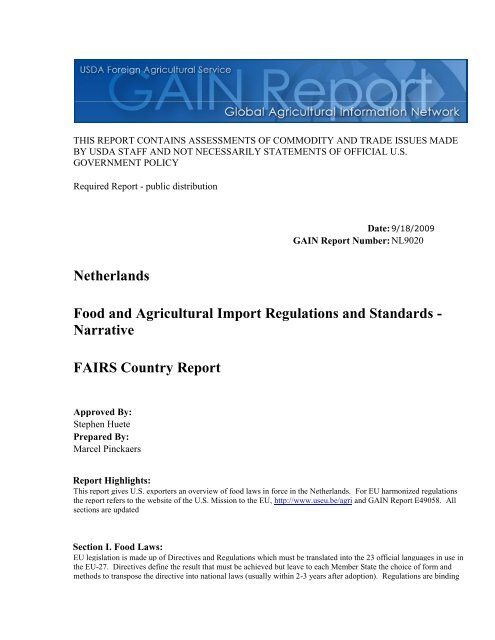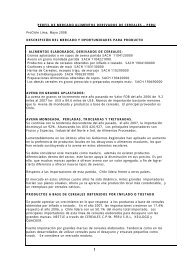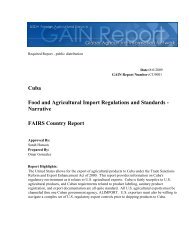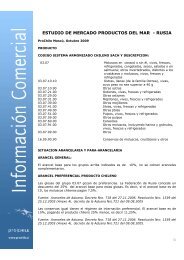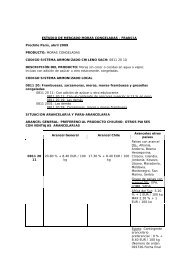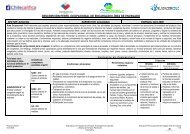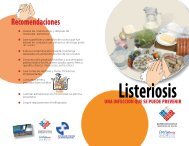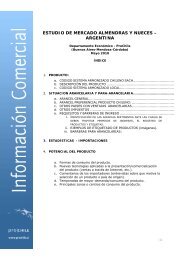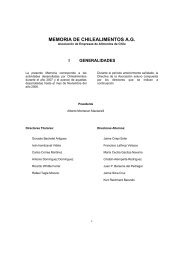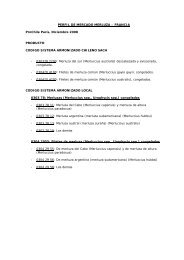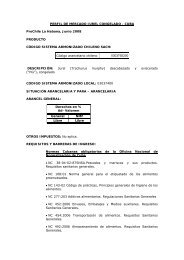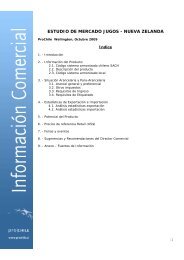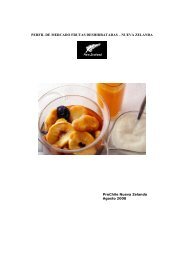Netherlands Food and Agricultural Import ... - Chilealimentos
Netherlands Food and Agricultural Import ... - Chilealimentos
Netherlands Food and Agricultural Import ... - Chilealimentos
Create successful ePaper yourself
Turn your PDF publications into a flip-book with our unique Google optimized e-Paper software.
THIS REPORT CONTAINS ASSESSMENTS OF COMMODITY AND TRADE ISSUES MADE<br />
BY USDA STAFF AND NOT NECESSARILY STATEMENTS OF OFFICIAL U.S.<br />
GOVERNMENT POLICY<br />
Required Report - public distribution<br />
<strong>Netherl<strong>and</strong>s</strong><br />
Date: 9/18/2009<br />
GAIN Report Number: NL9020<br />
<strong>Food</strong> <strong>and</strong> <strong>Agricultural</strong> <strong>Import</strong> Regulations <strong>and</strong> St<strong>and</strong>ards -<br />
Narrative<br />
FAIRS Country Report<br />
Approved By:<br />
Stephen Huete<br />
Prepared By:<br />
Marcel Pinckaers<br />
Report Highlights:<br />
This report gives U.S. exporters an overview of food laws in force in the <strong>Netherl<strong>and</strong>s</strong>. For EU harmonized regulations<br />
the report refers to the website of the U.S. Mission to the EU, http://www.useu.be/agri <strong>and</strong> GAIN Report E49058. All<br />
sections are updated<br />
Section I. <strong>Food</strong> Laws:<br />
EU legislation is made up of Directives <strong>and</strong> Regulations which must be translated into the 23 official languages in use in<br />
the EU-27. Directives define the result that must be achieved but leave to each Member State the choice of form <strong>and</strong><br />
methods to transpose the directive into national laws (usually within 2-3 years after adoption). Regulations are binding
in their entirety <strong>and</strong> automatically enter into force on a set date in all Member States. Amendments to EU legislation are<br />
usually published in new <strong>and</strong> separate Directives <strong>and</strong> Regulations.<br />
A Decision is binding entirely on those to whom it is addressed. No national implementing legislation is required. A<br />
Recommendation has no binding effect as it is not a law.<br />
Harmonization with the EU<br />
http://useu.usmission.gov/agri/harmonization.html<br />
The <strong>Netherl<strong>and</strong>s</strong>, as a member of the EU, conforms to all EU regulations <strong>and</strong> directives. This report therefore should<br />
be read in conjunction with the <strong>Food</strong> <strong>and</strong> <strong>Agricultural</strong> <strong>Import</strong> Regulations <strong>and</strong> St<strong>and</strong>ards (FAIRS) for the EU<br />
written by the U.S. Mission to the EU in Brussels, Belgium. For more information, please go to<br />
www.useu.be/agri.<br />
Regulation (EC) 178/2002 (General <strong>Food</strong> Law) is the harmonized regulation which sets out the general principles <strong>and</strong><br />
requirements of EU harmonized food law. Exporters should be aware that there may also be some variation among<br />
Member States in applying EU harmonized legislation; there may be temporary waivers or exemptions <strong>and</strong> in certain<br />
cases there may be room for interpretation of EU harmonized legislation or aspects, which are not regulated in detail at<br />
EU level, <strong>and</strong> may be h<strong>and</strong>led differently in different member states.<br />
The <strong>Netherl<strong>and</strong>s</strong><br />
The Dutch <strong>Food</strong> <strong>and</strong> Drugs Law is called “Warenwet.” This Warenwet provides the Dutch regulatory framework for all<br />
food <strong>and</strong> non-food products. It is applicable to domestically produced <strong>and</strong> imported products. Revisions of the Dutch<br />
<strong>Food</strong> <strong>and</strong> Drugs Law are published in the "Staatscourant". The <strong>Food</strong> <strong>and</strong> Drugs Law <strong>and</strong> revisions can be found on<br />
http://wetten.overheid.nl. At this website all other Dutch legislation can be found as well. (NOTE: website is in Dutch).<br />
The task of the <strong>Food</strong> <strong>and</strong> Consumer Product Safety Authority (VWA) is to protect human <strong>and</strong> animal health. It monitors<br />
food <strong>and</strong> consumer products to safeguard public health <strong>and</strong> animal health <strong>and</strong> welfare. The VWA is an independent<br />
agency in the Ministry of Agriculture, Nature <strong>and</strong> <strong>Food</strong> Quality <strong>and</strong> a delivery agency for the Ministry of Health,<br />
Welfare <strong>and</strong> Sport.<br />
The Dutch <strong>Food</strong> <strong>and</strong> Consumer Product Safety Authority (VWA)<br />
P.O. Box 19506<br />
2500 CM The Hague, the <strong>Netherl<strong>and</strong>s</strong><br />
Phone: +31-(0)70-4484848<br />
Fax: +31-(0)70-4484747<br />
www.vwa.nl<br />
info@vwa.nl<br />
The Plant Protection service (PD) is the body within the Dutch Ministry of Agriculture that is responsible for the<br />
phytosanitary inspections on imported products. An overview of plant products that are subject to inspection can be<br />
found at<br />
http://www.minlnv.nl/portal/page?_pageid=116,1640321&_dad=portal&_schema=PORTAL&p_file_id=15774.<br />
This website is updated regularly. For more information or questions for the PD, contact:<br />
Plantenziektenkundige Dienst (PD)<br />
Geertjesweg 15<br />
Postbus 9102<br />
6706 EA Wageningen<br />
Phone: +31 (0)317-496911<br />
Fax: +31 (0)317-421701<br />
pd.info@minlnv.nl<br />
www.minlnv.nl/pd
Since September 1, 2007, the Ministry of Agriculture, Nature <strong>and</strong> <strong>Food</strong> Quality transferred the inspection tasks of its PD<br />
to the following 4 inspection bodies (see Appendix III): NAK (<strong>Netherl<strong>and</strong>s</strong> General Inspection Service for <strong>Agricultural</strong><br />
Seeds <strong>and</strong> Seed potatoes), NAK-tuinbouw (<strong>Netherl<strong>and</strong>s</strong> Inspection Service for Horticulture), BKD (Flower Bulb<br />
Inspection Service) <strong>and</strong> KCB (Quality Control Bureau for Vegetables <strong>and</strong> Fruit). These four agencies carry out import<br />
inspections to detect plant diseases, as well as quality control inspections on fruit <strong>and</strong> vegetables. The Minister of<br />
Agriculture, Nature <strong>and</strong> <strong>Food</strong> Quality retains ultimate responsibility for these matters.<br />
Section II. Labeling Requirements:<br />
A. General requirements<br />
In the <strong>Netherl<strong>and</strong>s</strong>, the labeling requirements have been laid down in the Warenwetbesluit etikettering van<br />
levensmiddelen <strong>and</strong> can be found at http://wetten.overheid.nl. The <strong>Netherl<strong>and</strong>s</strong> follows EU legislation. For more<br />
detailed information, the reader may refer to the Dutch legislation, which is given in italics next to each item.<br />
Compulsory information:<br />
Description: Warenwetbesluit Etikettering van Levensmiddelen, art. 4<br />
List of ingredients: Warenwetbesluit Etikettering van Levensmiddelen, art. 6<br />
Allergens: Warenwetbesluit Etikettering van Levensmiddelen<br />
Net quantity: Warenwetbesluit Etikettering van Levensmiddelen, art. 11<br />
Shelf-life: Warenwetbesluit Etikettering van Levensmiddelen, art. 16 <strong>and</strong> art. 17<br />
For a shelf-life up to 3 month after the date of<br />
production<br />
Tenminste houdbaar tot<br />
(best before)<br />
Day, Month, (Year)<br />
For a shelf-life between 3 <strong>and</strong> 18 months Tenminste houdbaar tot einde<br />
(best before end)<br />
Month, year<br />
For a shelf-life longer than 18 months Tenminste houdbaar tot einde<br />
(best before end)<br />
Year<br />
For Highly perishable foodstuffs Te gebruiken tot<br />
(use by)<br />
Day, Month, (Year)<br />
Name <strong>and</strong> address: Warenwetbesluit Etikettering van Levensmiddelen, art. 19<br />
In addition to the date, the instructions for storage<br />
have to be mentioned as well
Place of origin: Warenwetbesluit Etikettering van Levensmiddelen, art. 20<br />
Instructions for storage <strong>and</strong>/or use: Warenwetbesluit Etikettering van Levensmiddelen, art. 16 <strong>and</strong> art. 17<br />
Percentage of alcohol: Warenwetbesluit Etikettering van Levensmiddelen, art. 21<br />
Lot marking: Warenwetbesluit Etikettering van Levensmiddelen, art. 22<br />
Additives: Warenwetbesluit Etikettering van Levensmiddelen, art. 7<br />
Quinine <strong>and</strong> caffeine:<br />
Warenwetbesluit bereiding en beh<strong>and</strong>eling van levensmiddelen in verb<strong>and</strong> met de etikettering van levensmiddelen met<br />
kinine en cafeine<br />
Phytosterols & Phytostanols:<br />
Commission Regulation 608/2004 lays down labeling requirements for foods <strong>and</strong> food ingredients with added<br />
phytosterols, phytosterol esters, phytostanols <strong>and</strong> phytostanol esters (used to reduce cholesterol levels).<br />
Quantitative Ingredients Declaration (QUID):<br />
Warenwetbesluit Etikettering van Levensmiddelen, art. 10<br />
Warning on labels:<br />
Commission Directive 2008/5/EC establishes a list of foodstuffs that require a warning on the label:<br />
foodstuffs whose durability has been extended by means of packaging gases<br />
foodstuffs containing (a) sweetener(s)<br />
foodstuffs containing added sugar(s) <strong>and</strong> sweetener(s)<br />
foodstuffs containing aspartame<br />
foodstuffs containing more than 10% added polyols<br />
confectionery or beverages containing liquorice<br />
As of July 20, 2010, Regulation 1333/2008 (see section IV) requires foodstuffs containing the food colors sunset yellow<br />
(E110), quinoline yellow (E104), carmoisine (E122), allura red (E129) <strong>and</strong> ponceau 4R (E124) to be labeled “may have<br />
an adverse effect on activity <strong>and</strong> attention in children”. <strong>Food</strong> placed on the market or labeled before July 20, 2010,<br />
which do not comply with this provision may be marketed until their date of minimum durability or use-by-date.<br />
Language requirements:<br />
Warenwetbesluit Etikettering van Levensmiddelen, art. 23<br />
Stick-on labels:<br />
Warenwetbesluit Etikettering van Levensmiddelen, art. 24<br />
Samples:<br />
Warenwetbesluit Etikettering van Levensmiddelen, art. 1
Institutional packed products:<br />
Warenwetbesluit Etikettering van Levensmiddelen, art. 24<br />
Exceptions:<br />
Only the Federal Minister of Agriculture can grant an exception to the existing labeling regulations. The granting of an<br />
exception would be very rare.<br />
B. Medical/Health/Nutrition Claims<br />
The development of nutrient profiles, originally scheduled for January 2009, is being delayed until September<br />
2009. Once the nutrient profiles, based on scientific evaluations by the European <strong>Food</strong> Safety Authority (EFSA), have<br />
been set, there will be another two-year period before the nutrient profiles begin to apply to allow food operators time to<br />
comply with the new rules. Nutrition claims can fail one criterion, i.e. if only one nutrient (salt, sugar or fat) exceeds<br />
the limit of the profile, a claim can still be made provided the high level of that particular nutrient is clearly marked on<br />
the label. For example, a yogurt can make a low-fat claim even if it has a high sugar content but only if the label clearly<br />
states “high sugar content”. Health claims cannot fail any criteria.<br />
New products on the EU market must respect the conditions for using nutrition claims set out in detail in the Annex of<br />
Regulation 1924/2006. Products already labeled or on the market before January 2007 may remain on the market with<br />
the old labels until January 2010. From 2010, only nutrition claims included in the Annex will be allowed.<br />
A list of well-established health function claims such as “calcium is good for your bones” will be established by<br />
January 2010, based on Member States’ lists of health claims already approved at national level. Disease risk reduction<br />
claims were previously not allowed in the EU which means that there is no transitional period for such claims. Disease<br />
risk reduction claims <strong>and</strong> claims referring to the health <strong>and</strong> development of children will require an authorization on a<br />
case-by-case basis, following the submission of a scientific dossier to EFSA. Health claims based on new scientific<br />
data will have to be submitted to EFSA for evaluation but a simplified authorization procedure has been<br />
established. GAIN Report E48055 describes how application dossiers for authorization of health claims should be<br />
prepared <strong>and</strong> presented. A guidance document on how companies can apply for health claim authorizations can be<br />
downloaded from EFSA’s website at http://www.efsa.europa.eu/EFSA/ScientificPanels/NDA/efsa_locale-<br />
1178620753812_1178684448831.htm.<br />
Trade marks <strong>and</strong> br<strong>and</strong> names that suggest health <strong>and</strong>/or nutritional benefits but do not comply with the new rules must<br />
be entirely removed from the EU market within 15 years.<br />
For the approval of claims, U.S. exporters <strong>and</strong>/or Dutch importers can send the text (claim) to:<br />
KOAG/KAG<br />
Postbus 90445,<br />
1006 BK Amsterdam, the <strong>Netherl<strong>and</strong>s</strong><br />
Phone: +31-(0)20-7130720<br />
Fax: +31-(0)20-7130721<br />
Email: keuringsraad@koagkag.nl
www.koagkag.nl. (Code voor de Aanprijzing van Gezondheids-producten)<br />
Requirements specific to nutritional labeling<br />
In October 2008, Council Directive 90/496/EEC was amended by Commission Directive 2008/100/EC. Commission<br />
Directive 2008/100/EC updates the list of vitamins <strong>and</strong> minerals <strong>and</strong> their Recommended Daily Allowances (RDAs)<br />
<strong>and</strong> provides an EU definition of “fiber”. The conditions for the use of nutrition claims such as “source of fiber” or<br />
“high fiber” are laid down in Regulation 1924/2006 (see nutrition <strong>and</strong> health claims).<br />
Warenwetbesluit Voedingswaarde-informatie Levensmiddelen, § 2. voedingswaarde etikettering<br />
C. Product-Specific Labeling<br />
See Section VII<br />
D. Country of Origin labeling<br />
In the EU, country of origin labeling is m<strong>and</strong>atory for beef <strong>and</strong> veal, fruit <strong>and</strong> vegetables, eggs, poultry meat, wine,<br />
honey, olive oil, aquaculture products <strong>and</strong> organic products (as of 2010). For other products, the indication of the place<br />
of origin or provenance is m<strong>and</strong>atory only if the omission of such information might mislead the consumer.<br />
Section III. Packaging <strong>and</strong> Container Regulations:<br />
A. Pack sizes<br />
Directive 2007/45/EC abolishes regulations on m<strong>and</strong>atory pack sizes at both EU <strong>and</strong> national levels. The Directive frees<br />
sizes for all prepackaged products except wine <strong>and</strong> spirits, coffee <strong>and</strong> white sugar. Member States in which m<strong>and</strong>atory<br />
nominal quantities are prescribed for milk, butter, dried pasta <strong>and</strong> coffee may maintain their restrictive rules until<br />
October 2012. The rules for white sugar may be maintained until October 2013. M<strong>and</strong>atory nominal quantities for<br />
wines <strong>and</strong> spirits are set out in the Annex to Directive 2007/45/EC<br />
Warenbesluit containers<br />
C. Material in contact with food stuffs<br />
Commission Regulation 450/2009 sets out definitions <strong>and</strong> authorization procedures for the use of active <strong>and</strong> intelligent<br />
materials <strong>and</strong> articles intended to come into contact with food.<br />
Commission Regulation 2023/2006 lays down rules on good manufacturing practice (GMP) for the groups of materials<br />
<strong>and</strong> articles intended to come into contact with food listed in annex I to Regulation 1935/2004.<br />
Exporters are advised to verify if a Member State follows EU provisions as Member States are allowed to authorize<br />
provisionally the use of certain substances not listed in one of the specific directives. They may also restrict or<br />
temporarily prohibit the use of certain materials authorized by the specific directives for reasons of public health. A<br />
summary of national legislation can be downloaded from the European Commission website at<br />
http://ec.europa.eu/food/food/chemicalsafety/foodcontact/sum_nat_legis_en.pdf.<br />
Warenwetbesluit Verpakkingen en Gebruiksartikelen<br />
Verpakkingsverordening productschap dranken 2003<br />
Regeling Verpakkingen- en Gebruiksartikelen<br />
Section IV. <strong>Food</strong> Additives Regulations:<br />
In December 2008, the proposal for a legislative “Package on food Improvement Agents” was adopted. The package<br />
includes four new regulations: Regulation 1331/2008 establishing a common authorization procedure for food additives,<br />
food enzymes <strong>and</strong> food flavorings, Regulation 1332/2008 on food enzymes, Regulation 1333/2008 on food additives <strong>and</strong><br />
Regulation 1334/2008 on flavorings.<br />
Additives:<br />
New Regulation 1333/2008 on food additives brings the current miscellaneous additives directive <strong>and</strong> the directives on<br />
colors <strong>and</strong> sweeteners into one regulation <strong>and</strong> will apply as of January 20, 2010 (except for the transitional<br />
provisions). It provides for the establishment of an EU positive list, conditions of use <strong>and</strong> rules on the of additives sold
as such.<br />
Additives that are permitted under the existing directives will be entered in the EU positive list of authorized additives<br />
(Annex II to Regulation 1333/2008) after a review of their compliance with the new provisions. This review should be<br />
completed by January 2011. Until the completion of the review, the use of food additives permitted under the current<br />
directives will continue to be permitted. An important difference from U.S. legislation is the use of flour bleaching<br />
agents: chlorine, bromates <strong>and</strong> peroxides are not allowed in the EU.<br />
Warenwetbesluit Levensmiddelenadditieven<br />
All additives not included on these positive lists are prohibited except for new food additives that receive a temporary<br />
authorization by Member States. Throughout the years there have been only a few food additives temporarily authorized<br />
by The <strong>Netherl<strong>and</strong>s</strong>. The VWA can be contacted on temporary authorizations, see Appendix I.<br />
Labeling requirements for additives:<br />
The addition of a new food additive to the EU positive list is a lengthy process. However, any Member State can allow<br />
the domestic use of a new food additive on their territory for a two-year period. The Ministers of Health, Welfare <strong>and</strong><br />
Sports, of Agriculture, Nature <strong>and</strong> <strong>Food</strong> Quality, <strong>and</strong> of Economic Affairs can approve this. To request two-year<br />
authorization for marketing of a new additive, contact:<br />
The VWA<br />
P.O. Box 19506<br />
2500 CM The Hague, The <strong>Netherl<strong>and</strong>s</strong><br />
Phone: +31-(0)70-4484848<br />
Fax: +31-(0)70-4484747<br />
www.vwa.nl<br />
info@vwa.nl<br />
Flavorings:<br />
Regulation 1334/2008 on flavorings <strong>and</strong> certain food ingredients with flavoring properties updates the current legislation<br />
<strong>and</strong> sets specific rules for the use of the term “natural”. The EU positive list of authorized flavorings has to be adopted<br />
at the latest by December 31, 2010. The new rules will apply as of January 20, 2011.<br />
Enzymes:<br />
Regulation 1332/2008 on food enzymes introduces harmonized rules for their scientific evaluation <strong>and</strong> authorization in<br />
the EU <strong>and</strong> establishes labeling requirements. Until the adoption of an EU positive list of authorized enzymes, the<br />
existing national provisions on the marketing of food enzymes will continue to apply.<br />
Processing Aids:<br />
A list of extraction solvents allowed in the production of foodstuffs <strong>and</strong> food ingredients, along with their conditions of<br />
use has been established in Council Directive 2009/32/EC.<br />
Section V. Pesticides <strong>and</strong> Other Contaminants:<br />
Pesticides:<br />
The legislation on pesticides <strong>and</strong> contaminants is partially harmonized in the EU. Enforcement of both EU <strong>and</strong><br />
remaining Member State rules is done at the Member State level.<br />
The marketing <strong>and</strong> use of plant protection products is regulated by Council Directive 91/414/EEC. This Directive<br />
provides for the establishment of an EU positive list of active substances. Active substances are being reviewed under<br />
this Directive <strong>and</strong> may only be used in plant protection products when they are included in the positive list. Only<br />
products containing substances included in the positive list may be authorized for use in the EU. The currently ongoing<br />
legislative initiatives in the area of pesticides are resulting in a drastic reduction of the number of active substances, <strong>and</strong><br />
maximum residue levels (MRLs) are being harmonized throughout the EU.<br />
On September 1, 2008, framework Regulation 396/2005 on maximum levels of pesticides in or on food <strong>and</strong> feed of plant
<strong>and</strong> animal origin became fully applicable replacing old Directives 86/362/EEC, 86/363/EEC <strong>and</strong> 90/642/EEC.<br />
Contaminants:<br />
EU wide harmonized maximum levels for contaminants are set in the Annex of Commission Regulation<br />
1881/2006. Commission Decision 2006/504/EC sets special conditions for the import of foodstuffs from certain third<br />
countries due to contamination risks by aflatoxins. An update of the Commission’s “Guidance document for competent<br />
authorities for the control of compliance with EU legislation on aflatoxins” was published in March 2009. Commission<br />
Decision 2007/563/EC, an amendment to Decision 2006/504/EC, sets special conditions for the import of U.S. almonds<br />
into the EU. The decision applies to almonds in shell or shelled, roasted almonds, <strong>and</strong> mixtures of nuts or dried fruits<br />
containing almonds, <strong>and</strong> foodstuffs containing a significant amount of almonds (at least 10 percent). Official Member<br />
States controls are carried out on approximately 5 percent of consignments of foodstuffs which are covered by the<br />
“Voluntary Aflatoxin Sampling Plan” (VASP) <strong>and</strong> to each consignment of foodstuffs not covered by the VASP. More<br />
information is available on the Almond Board of California’s website.<br />
Official Controls of Maximum Levels in <strong>Food</strong>stuffs:<br />
The following regulations concern the sampling methods <strong>and</strong> methods of analysis for the official controls of the levels of<br />
the different contaminants. Annex I describes the methods of sampling; Annex II concerns the sample preparation <strong>and</strong><br />
the performance criteria for the methods of analysis:<br />
Nitrates: Commission Regulation 1882/2006<br />
Mycotoxins: Commission Regulation 401/2006<br />
Dioxins: Commission Regulation 1883/2006<br />
Heavy metals: Commission Regulation 333/2007<br />
Residues in Animals <strong>and</strong> Animal Product:<br />
The monitoring of residues in animals <strong>and</strong> animal products is addressed separately in Council Directive 96/23/EC. This<br />
directive includes the monitoring of the above-mentioned pesticide residues but includes also the monitoring of residues<br />
of veterinary drugs <strong>and</strong> a wide range of other contaminants <strong>and</strong> undesired substances such as residues of growth<br />
promotants. The prohibition of the use of hormones in meat production is addressed in Council Directive 96/22/EEC<br />
(amended by Directive 2008/97/EC).<br />
Section VI. Other Regulations <strong>and</strong> Requirements:<br />
Product inspection <strong>and</strong> registration<br />
Member States are responsible for carrying out inspections on a regular basis <strong>and</strong> in cases where non-compliance is<br />
suspected. Products can be checked at import or at all further stages of marketing. Infringements of EU food <strong>and</strong> feed<br />
legislation are reported through the Rapid Alert System on <strong>Food</strong> <strong>and</strong> Feeds (RASFF). In the <strong>Netherl<strong>and</strong>s</strong> the VWA <strong>and</strong><br />
the PD are responsible for the inspections.<br />
Criteria for laboratories conducting food controls have been harmonized but it is the Member States’ responsibility to<br />
designate laboratories that are allowed to perform analyses. A list of laboratories designated by the <strong>Netherl<strong>and</strong>s</strong> to<br />
perform analysis can be found at the following internet link, www.rva.nl. Different laboratories are accredited for the<br />
different type of controls.<br />
Dutch Accreditation Council (RVA)<br />
P.O. Box 2768<br />
3500 GT Utrecht, The <strong>Netherl<strong>and</strong>s</strong><br />
T: +31 (0)30 23 94 500<br />
F: +31 (0)30 23 94 539<br />
postmaster@rva.nl<br />
Section VII. Other Specific St<strong>and</strong>ards:<br />
C. Fortified foods<br />
Regulation 1925/2006 establishes an EU-wide regulatory framework for the addition of vitamins, minerals <strong>and</strong> certain<br />
other substances such as herbal extracts to foods. It lists the vitamins <strong>and</strong> minerals that may be added to foods <strong>and</strong> sets
criteria for setting maximum <strong>and</strong> minimum levels. The Commission proposal setting minimum <strong>and</strong> maximum levels,<br />
originally scheduled for January 2009, is being delayed until the end of 2009. The use of vitamins <strong>and</strong> minerals not<br />
included in the annexes to Regulation 1925/2006 is not allowed. However, Member States may under certain conditions<br />
provide for a temporary derogation (until January 19, 2014) for vitamins <strong>and</strong> minerals not included in the<br />
annexes. <strong>Food</strong>s not complying with the new rules may be marketed until December 31, 2009, if they were put on the<br />
market or labeled before July 1, 2007 (date of entry into force of the regulation).<br />
D. Dietetic or special use foods<br />
Warenwetbesluit Producten voor Bijzondere Voeding<br />
New framework Directive 2009/39/EC consolidates Directive 89/398/EEC <strong>and</strong> all its amendments into a single text <strong>and</strong><br />
lays down rules for foodstuffs intended for particular nutritional uses. These are foodstuffs which, due to their special<br />
composition or manufacturing process, can clearly be distinguished from foodstuffs for normal<br />
consumption. Commission Directive 2001/15/EC lists the chemical substances in each category of nutritional<br />
substances (vitamins, minerals <strong>and</strong> amino acids) that may be added for specific nutritional purposes in foodstuffs for<br />
particular nutritional uses.<br />
Specific directives on foods <strong>and</strong> beverages for sports people or on foods intended for diabetics are still subject to<br />
Member State legislation. The introduction of foodstuffs intended for particular nutritional uses for which no specific<br />
rules are set must be notified to the Member State where the food is sold. The competent authority for the <strong>Netherl<strong>and</strong>s</strong><br />
is:<br />
<strong>Food</strong> <strong>and</strong> Consumer Product Safety Authority (VWA)<br />
P.O. Box 19506<br />
NL - 2500 CM The Hague, The <strong>Netherl<strong>and</strong>s</strong><br />
Mrs. Yvonne Huigen<br />
Tel: + 31 70 448 4806<br />
Fax: + 31 70 448 4061<br />
E-mail: yvonne.huigen@vwa.nl<br />
F. Wine, Beer <strong>and</strong> other Alcoholic beverages<br />
Council Regulation 479/2008 reorganizes the way the EU wine market is managed. It establishes general rules,<br />
applicable as of August 1, 2009, on oenological practices, designations of origin <strong>and</strong> labeling. Measures for the adoption<br />
of Regulation 479/2008 were published on July 24, 2009 (Official Journal L 193).<br />
Commission Regulation 606/2009 lays down detailed rules for implementing Regulation 479/2008 as regards permitted<br />
oenological practices. Annex I A sets out the oenological practices authorized in the EU <strong>and</strong> the conditions for their<br />
use. For experimental purposes, Member States may authorize the use of certain oenological practices not provided for<br />
in the relevant EU regulations for a maximum of three years. Annex I B sets out the maximum allowed sulphur dioxide<br />
contents: 150 mg per liter for red wines, 200 mg per liter for white <strong>and</strong> rosé wines.<br />
Commission Regulation 607/2009 lays down detailed rules for implementing:<br />
Chapter IV of Title III of Regulation 479/2009 relating to protected designations of origin <strong>and</strong> geographical<br />
indications<br />
Chapter V of Title III of Regulation 479/2008 relating to traditional terms<br />
Chapter VI of Title III of Regulation 479/2008 relating to the labeling <strong>and</strong> presentation of wine sector products.<br />
G. Organic foods<br />
Council Regulation 834/2007 lays down a new legal framework for organic production <strong>and</strong> the labeling of organic<br />
products. Title IV of this new regulation lays down general rules for the labeling of organic products; Title VI covers<br />
trade with third countries. Commission Regulation 889/2008 lays down detailed rules for the implementation of<br />
Regulation 834/2007 with regard to production, labeling <strong>and</strong> control. The use of an EU organic logo will become<br />
m<strong>and</strong>atory for products produced in the EU but will be optional for organic products from third countries. However, due<br />
to “technical” problems with the design, the use of a new EU organic logo will be delayed until July 2010. Regulation
834/2007 entered into force on January 1, 2009 <strong>and</strong> repeals Council Regulation 2092/91. The new EU rules on organic<br />
food labeling are explained in GAIN report E48106.<br />
Commission Regulation 1235/2008 lays down rules for the implementation of Regulation 834/2007 as regards the<br />
arrangements for imports of organic products from third countries. In order to export organic products to the EU, third<br />
countries must prove that their production st<strong>and</strong>ards are equivalent to the EU st<strong>and</strong>ards. For third countries currently not<br />
included in the EU’s equivalency list, such as the U.S., the Commission will compile a list of recognized control bodies<br />
<strong>and</strong> control authorities. To be included in the EU list, U.S. control bodies/authorities must submit a technical<br />
dossier. The Commission will only consider complete dossiers submitted before October 31, 2011. To avoid trade<br />
disruptions, Regulation 1235/2008 establishes transitional rules allowing Member States, until January 1, 2013, to<br />
continue to grant authorizations to importers of U.S. organic products on a case-by-case basis. Authorizations will<br />
expire at the latest 24 months after the publication of the first list of control bodies/authorities. Shipments of organic<br />
products must be accompanied by the model certificate established by Regulation 1235/2008.<br />
While organic st<strong>and</strong>ards have been set at the EU level, implementation <strong>and</strong> enforcement of the regulation is the<br />
responsibility of the individual member states. This member state responsibility also extends to imports of organic<br />
products. For the importation of organic products from outside the EU, the Dutch importer needs an import certificate<br />
<strong>and</strong> an import authorization. The import certificate is issued by Skal* while the import authorization is issued by Dienst<br />
Regelingen**, the executive body of the Ministry of agriculture.<br />
* SKAL<br />
P.O. Box 384<br />
8000 AJ Zwolle, <strong>Netherl<strong>and</strong>s</strong><br />
Ph: +31 (0)38 426 8181<br />
Fax: +31 (0)38 421 3063<br />
info@skal.nl<br />
www.skal.nl<br />
**Dienst Regelingen<br />
P.O. Box 965<br />
6040 AZ Roermond, the <strong>Netherl<strong>and</strong>s</strong><br />
Phone: +31 (0)475 355 444<br />
Fax: +31 (0)475 318 939<br />
M. Seafood<br />
Detailed information on exporting U.S. seafood to the EU is available in the 2009 update of the “How to export seafood<br />
to the European Union” guide which can be downloaded from<br />
http://useu.usmission.gov/agri/_private/How%20to%20export%20seafood%202009.pdf.<br />
N. Pet <strong>Food</strong><br />
The current EU rules (detailed information available on the U.S. mission to the EU website) which are scattered over a<br />
series of directives <strong>and</strong> regulations have a direct impact on the production <strong>and</strong> marketing of pet food. In June 2009, a<br />
new framework regulation was adopted which will replace the existing rules <strong>and</strong> implement labeling <strong>and</strong> marketing rules<br />
in a more uniform way. Labeling rules will be similar to those for food for human consumption, i.e. ingredients must be<br />
listed in descending order of weight. If the presence of a certain feed material is emphasized, its exact percentage by<br />
weight must be indicated. The new regulation has not been published yet in the Official Journal but will probably enter<br />
into force in the beginning of 2010.<br />
Section VIII. Copyright <strong>and</strong>/or Trademark Laws:<br />
Copyright<br />
The <strong>Netherl<strong>and</strong>s</strong> <strong>and</strong> the U.S. are both members of the Universal Copyright Convention of Geneva. As a consequence,<br />
works by U.S. authors, copyrighted in the U.S., are also protected in the <strong>Netherl<strong>and</strong>s</strong>.<br />
Trademarks<br />
Council Regulation 207/2009 lays down rules for the registration of Community trademarks. It creates a single, unitary<br />
registration system covering the whole Community.
In practice, a Community trademark must meet two conditions: it must be a sign which can be represented in graphic<br />
form, <strong>and</strong> it must make it possible to distinguish goods <strong>and</strong> services from those of another company. It is valid for a<br />
period of 10 years. Applications for registering Community trademarks under these regulations may be filed with the<br />
Alicante, Spain, based Office of Harmonization for the Internal Market, subject to the fees set out in Commission<br />
Regulation 2869/95, or at a national industrial property office in a Member State of the European Union.<br />
On completion of the registration procedure, the trademark is registered in the Register of Community trademarks.<br />
The Community Trademark did not replace the existing trademark laws of the member states but co-exists alongside<br />
national trademarks. Directive 2008/95/EC approximates the laws of the Member States relating to trademarks.<br />
Trademark registration in the <strong>Netherl<strong>and</strong>s</strong> is based on Benelux legislation. Registration can be obtained for all 3<br />
Benelux countries (Belgium, <strong>Netherl<strong>and</strong>s</strong> <strong>and</strong> Luxembourg) through one process. Applications for trademark<br />
registration in the Benelux can be sent to:<br />
Benelux Merkenbureau (Benelux Trademark Office)<br />
Bordewijklaan 15<br />
2591 XR The Hague, the <strong>Netherl<strong>and</strong>s</strong><br />
Phone: +31-(0)70-3491111.<br />
In the Benelux countries, an international trademark can also be registered, as regulated by the Treaty of Madrid. This<br />
trademark offers protection to all nine EU countries that signed the convention.<br />
Section IX. <strong>Import</strong> Procedures:<br />
Council Regulation 2913/92 establishes the Community Customs Code. Commission Regulation 2454/93 lays down<br />
provisions for the implementation of the Code. The Code lists all the customs procedures applicable to the trade in<br />
goods with third countries. <strong>Import</strong> duties are determined by the tariff classification of goods <strong>and</strong> by the customs<br />
value. With the implementation of the Code, the Member States of the European Union form a customs union which<br />
means that all the Member States apply the same tariff on goods imported from outside the EU. Once an imported good<br />
is cleared in one Member State, it can move freely throughout the EU.<br />
The EU uses the Combined Nomenclature (CN) for the customs classification of goods. The CN eight digit code<br />
numbers are based on the Harmonized System (HS) nomenclature: the first six digits refer to the HS headings; the two<br />
following digits represent the CN subheadings. The EU’s on-line customs database can be consulted to look up<br />
commodity codes <strong>and</strong> relevant import duties: http://ec.europa.eu/taxation_customs/dds/tarhome_en.htm<br />
It is also possible to obtain Binding Tariff Information (BTI) from a member state’s customs authority to get the proper<br />
product classification. Through this system, traders know in advance the tariff classification of the goods they intend to<br />
import. BTI is legally binding in all the member states. Information on how to obtain a BTI can be downloaded from the<br />
European Commission’s Taxation & Custom’s website at:<br />
http://ec.europa.eu/taxation_customs/customs/customs_duties/tariff_aspects/classification_goods/index_en.htm<br />
A list of customs authorities can be found at: http://ec.europa.eu/taxation_customs/common/links/customs/index_en.htm<br />
The customs value of a good is the CIF price at the European border derived from the product price found on the invoice<br />
<strong>and</strong> the transportation costs reflected in the airway bill or the bill of lading.<br />
Goods are only released after payment of the import duty <strong>and</strong> other taxes that may be due. Duties payable on goods<br />
imported into the EU may include:<br />
- import duty (expressed as ad valorem tariffs or specific tariffs per unit weight/volume/number of pieces)<br />
- additional duties on flour <strong>and</strong> sugar (processed products)<br />
- entry price (fruit <strong>and</strong> vegetables)<br />
- environmental taxes - not harmonized<br />
- inspection fees - not harmonized<br />
- Value Added Tax (VAT) - not harmonized
- excise duties (alcohol <strong>and</strong> tobacco) - not harmonized<br />
A list of VAT rates applicable in the different Member States can be found on the Internet at:<br />
http://ec.europa.eu/taxation_customs/taxation/vat/consumers/vat_rates/index_en.htm<br />
A list of excise duties applicable on alcoholic beverages <strong>and</strong> tobacco can be found at:<br />
http://ec.europa.eu/taxation_customs/taxation/excise_duties/alcoholic_beverages/rates/index_en.htm <strong>and</strong><br />
http://ec.europa.eu/comm/taxation_customs/taxation/excise_duties/tobacco_products/rates/index_en.htm respectively.<br />
Other customs procedures described in detail in the Code include entry into free zones, situations where no import duty<br />
is payable: e.g. the inward processing regime, under which goods can be imported for processing but the finished<br />
product must be exported from the Community market. The Code also provides for a two-stage right of appeal lodged in<br />
the Member State where a decision has been taken or applied for: in the first instance to the customs authority, then to<br />
the national courts.<br />
Proposal: The modernised Community Customs Code (Regulation (EC) 450/2008) simplifies legislation <strong>and</strong> streamlines<br />
customs process <strong>and</strong> procedures for the benefit of both customs authorities <strong>and</strong> traders. Furthermore, the modernised<br />
Customs Code<br />
- Introduces the electronic lodging of customs declarations <strong>and</strong> accompanying documents as the rule;<br />
- Promotes the concept of centralised clearance, under which authorised traders are able to declare goods electronically<br />
<strong>and</strong> pay their customs duties at the place where they are established, irrespective of the Member State through which the<br />
goods are brought in or out of the EU customs territory or in which they will be consumed.<br />
-Offers a basis for the development of the Single Window <strong>and</strong> one-stop-shop concepts. Under the Single Window<br />
concept, economic operators provide information for import <strong>and</strong> export, required by customs <strong>and</strong> non-customs<br />
legislation, in a simple <strong>and</strong> efficient way - through a single entry point - even if the information should reach different<br />
administrations/agencies. Consequently, the controls on goods for various purposes can be performed at the same time<br />
<strong>and</strong> at the same place ('one-stop-shop' concept). It is not yet fully applicable due to several transition derogations.<br />
More information on the Dutch customs offices can be obtained at: http://www.belastingdienst.nl/9229237/v/eindex.htm<br />
Customs provides information of imports from which the VWA selects the lots for further inspection. Regulation<br />
2004/882/EC sets out the st<strong>and</strong>ards for control of compliance with the General <strong>Food</strong> Law.<br />
More information about the Dutch import regulations <strong>and</strong> st<strong>and</strong>ards can be obtained by contacting FAS/The Hague:<br />
Marcel Pinckaers<br />
Office of <strong>Agricultural</strong> Affairs<br />
U.S. Embassy<br />
Lange Voorhout 102<br />
2514 EJ The Hague, The <strong>Netherl<strong>and</strong>s</strong><br />
Tel: +31-(0)70-3102299<br />
Fax: +31-(0)70-3657681<br />
Email: agthehague@fas.usda.gov<br />
www.usembassy.nl/fas.html<br />
Appendix I. Government Regulatory Agency Contacts:<br />
1) Ministry of Agriculture, Nature <strong>and</strong> <strong>Food</strong> Quality<br />
PO Box 20401<br />
2500 EK The Hague, The <strong>Netherl<strong>and</strong>s</strong><br />
Phone: +31 (0)70 378 6868<br />
www.minlnv.nl<br />
2) Ministry of Health, Welfare <strong>and</strong> Sport
PO Box 20350<br />
2500 EJ The Hague, The <strong>Netherl<strong>and</strong>s</strong><br />
Phone: +31 (0)70 340 7911<br />
www.minvws.nl<br />
3) The Dutch <strong>Food</strong> <strong>and</strong> Consumer Product Safety Authority (VWA)<br />
P.O. Box 19506<br />
2500 CM The Hague, The <strong>Netherl<strong>and</strong>s</strong><br />
Phone: +31-(0)70-4484848<br />
Fax: +31-(0)70-4484747<br />
www.vwa.nl<br />
info@vwa.nl<br />
4) Plantenziektekundige Dienst (PD)<br />
Ministry Agriculture, Nature <strong>and</strong> <strong>Food</strong> Quality Geertjesweg 15<br />
Postbus 9102<br />
6700 HC Wageningen<br />
Phone: +31-(0)317-496911<br />
Fax: +31-(0)317–421701<br />
www.minlnv.nl/pd<br />
Appendix II. Other <strong>Import</strong> Specialist Contacts:<br />
1) Stichting Skal<br />
P.O. Box 384<br />
8000 AJ Zwolle, <strong>Netherl<strong>and</strong>s</strong><br />
Ph: +31 (0)38 426 8181<br />
Fax: +31 (0)38 421 3063<br />
info@skal.nl<br />
www.skal.nl<br />
2) <strong>Netherl<strong>and</strong>s</strong> Association for the trade in dried fruit, spices <strong>and</strong> allied products<br />
Ms. Barbara Niemans<br />
Bezuidenhoutseweg 82<br />
2594 AX The Hague, The <strong>Netherl<strong>and</strong>s</strong><br />
Phone: +31 (0)70 383 3011<br />
Fax: +31 (0)70 347 5253<br />
secretariaat@nzv-org.nl<br />
www.zuidvruchten.nl<br />
3) Frugi Venta<br />
<strong>Netherl<strong>and</strong>s</strong> Association for the trade in fresh fruit <strong>and</strong> vegetables<br />
Bezuidenhoutseweg 82<br />
2594 AX The Hague<br />
PO Box 90410<br />
2509 LK The Hague<br />
Phone: +31 (0)70 33 55 010<br />
Fax: +31 (0)70 33 55 020<br />
info@frugiventa.nl<br />
www.frugiventa.nl<br />
4) Productschappencommissie Levensmiddelen Wetgeving<br />
Christine Rommens
Stadhoudersplantsoen 12<br />
PO Box 2502 LS The Hague<br />
Phone: +31 (0)70 370 8502<br />
Fax: +31 (0)70 370 8444<br />
c.rommens@hpa.agro.nl<br />
www.hpa.nl<br />
PHYTOSANITARY INSPECTIONS<br />
BKD<br />
Zwartelaan 2, 2161 AL, Lisse<br />
P.O. Box 300, 2160 AH, Lisse<br />
+31 (0)252 41 91 01<br />
+31 (0)252 41 78 56<br />
info@bkd.eu<br />
www.bkd.eu<br />
KCB<br />
Platinaweg 10, 2544 EZ, The Hague<br />
PO Box 43133, 2504 AC, The Hague<br />
+31 (0)70 30 88 00 0<br />
+31 (0)70 30 88 00 1<br />
kcb@kcb.nl<br />
www.kcb.nl<br />
NAK<br />
R<strong>and</strong>weg 14, 8304 AS, Emmeloord<br />
P.O. Box 1115, 8300 BC, Emmeloord<br />
+ 31 (0)527 63 54 00<br />
+ 31 (0)527 63 54 11<br />
nak@nak.nl<br />
www.nak.nl<br />
NAKTuinbouw<br />
Sotaweg 22<br />
PO BOx 40, 2370 AA, Roelofarendsveen<br />
+31 (0)71 332 62 62<br />
+31 (0)71 332 63 63<br />
www.naktuinbouw.nl


